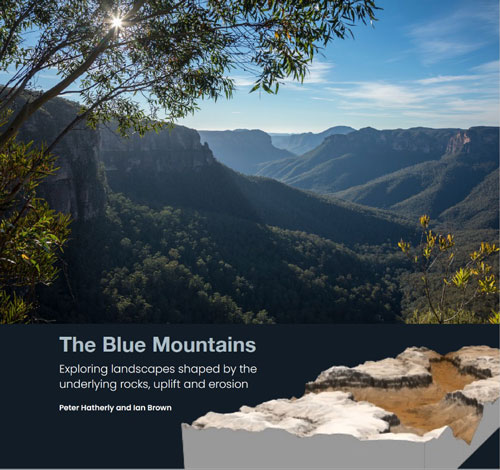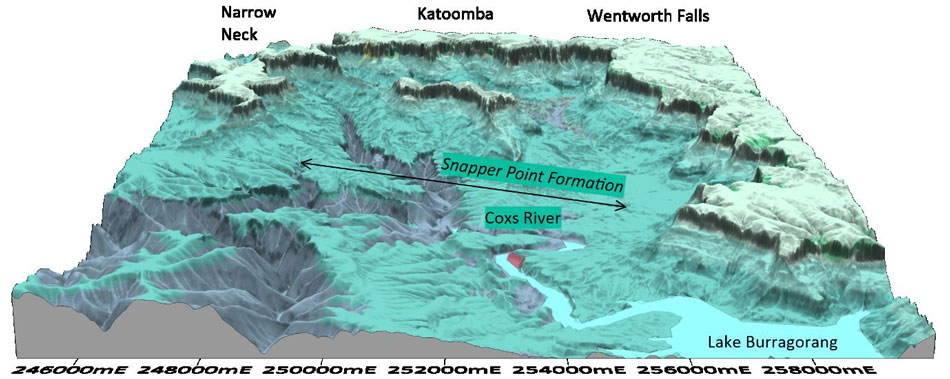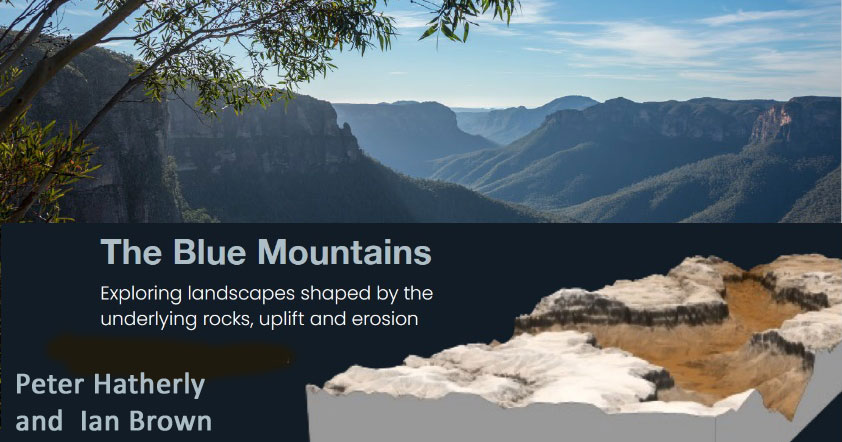of the underlying rocks, geological uplifts and erosion."
Wentworth Falls School of Arts
following the Society's AGM
reserve your place here
 Blue Mountains Landscapes book cover
Blue Mountains Landscapes book coverGeophysicist Peter Hatherly and naturalist Ian Brown, both avid bushwalkers, have addressed this limitation through a collaboration which combines stunning photographs, amazing maps based on airborne LiDAR data and text which gives a refreshing wholistic view on how the Blue Mountains have formed.
This talk will introduce the main underlying principles of the formation of the mountains starting with a summary of the main geological sequence and then explaining how the weathering and erosion of these rocks, in response to three main uplift events, has given us the present landscape.
Peter and Ian will explain the shapes of the valleys and introduce you to new ways of viewing them.
Explanations will be given for the V-shaped gorges in the basement rocks of the upper mountains, the broad valleys where the coal measure strata are exposed and the bottleneck gorges such as the Grose Valley.
As for the main sandstone clifflines, the LiDAR maps reveal the significant role landslides have played in the opening up of the valleys. An intriguing question is whether deep-seated failures within the underlying coal measure strata are contributing to the landslides.
The Blue Mountains have probably been shaped over the past 100 million years, starting with the breakup of Gondwana and continuing through to the present with the uplift of the contemporary Lapstone Monocline commencing some 10 million years ago.
This presentation will feature photographs and maps from Peter and Ian’ s forthcoming book, ‘The Blue Mountains, exploring landscapes shaped by the underlying rocks, uplift and erosion’.

Valleys of the Blue Mountains
South of Katoomba, the Snapper Point Formation defines a broad base level in the Kedumba Valley but this rock layer rises to the west and the Coxs River has eroded a deep V-shaped gorge within the basement rocks of the Sydney Basin.

Peter Hatherly
With BSc and PhD degrees in geophysics, Peter Hatherly has had a career in research, academia and consulting to the mining industry. As a keen bushwalker and resident of Sydney for most of his life, he is also familiar with most places in the Blue Mountains and what makes them tick, geologically. With regards to the Blue Mountains, he is the author and co-author of three papers on their geological evolution published by the Geological Society of Australia in the Australian Journal of Earth Sciences.
Now retired, the writing of this book has been a perfect project for the months of Covid restrictions. Geological interpretation is not a common genre in Australia. Peter hopes that the book fills a void and provides an accessible and refreshing explanation of the much-loved Blue Mountains.
Ian Brown
Ian developed a commitment to conservation at university and studied geomorphology and ecology, followed by a twenty-year career as a national park ranger and senior manager, mostly in the Blue Mountains. He then moved into private practice, consulting in protected area management and natural heritage interpretation (signage, publications, etc) while pursuing his photographic and writing interests as well as voluntary environmental work. He has been bushwalking and climbing since his teens, and has lived in the Blue Mountains with his family for nearly four decades.
With an abiding interest in landscape, this book is a major step in Ian’s almost lifelong habit of encouraging the appreciation and protection of the Greater Blue Mountains and the wider natural world.
– the Darug and Gundungurra people –
and pay respect to their Elders past, present and emerging.

 Blue Mountains Landscapes
Blue Mountains Landscapes